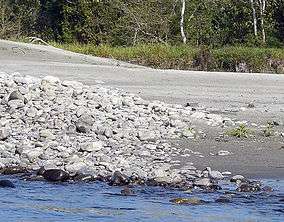Nameri National Park
| Nameri National Park | |
|---|---|
|
IUCN category II (national park) | |
|
Nameri National Park | |
 | |
| Location | Sonitpur Assam India |
| Nearest city | Tezpur, India |
| Coordinates | 27°0′36″N 92°47′24″E / 27.01000°N 92.79000°ECoordinates: 27°0′36″N 92°47′24″E / 27.01000°N 92.79000°E |
| Area | 200 km2 (77.2 sq mi) |
| Established | 1978 |
| Governing body | Ministry of Environment and Forests, Government of India |
Nameri National Park is a national park in the foothills of the eastern Himalayas in the Sonitpur District of Assam, India, about 35 km from Tezpur. Nameri is about 9 km from Chariduar, the nearest village.[1]
Nameri shares its northern boundary with the Pakhui Wildlife Sanctuary of Arunachal Pradesh. Together they constitute an area of over 1000 km2 of which Nameri has a total area of 200 km2.[2]
Etymology
The park was declared a reserve forest on 17 October 1978. It was set up as a Nameri Sanctuary on 18 September 1985 with an area of137 km2 as a part of Naduar Forest Reserve. Until then the Nameri National Park was heavily used for logging. Another 75 km2 was added on 15 November 1998 when it was officially established as a National Park.
The Jia Bhoroli river of Assam was famous since the time of British for the golden mahseer angling.[3]

Flora
The vegetation type of nameri is of semi-evergreen, moist deciduous forests with cane and bamboo brakes and narrow strips of open grassland along rivers. The forests are rich in epiphytes, lianas, and creepers and clump-forming bamboo.[2]
This forest has over 600 species. Some notable species are Gmelina arborea, Michelia champaca, Amari, Chukrasia tabularis, Ajar, Urium poma, Bhelou, Agaru, Rudraksha, Bonjolokia, Hatipolia akhakan, Terminalia myriocarpa, Mesua ferrca. It is home for orchids like Dendrobium, Cymbidium and Cypripedioideae.[3]

Fauna
This is excellent elephant country and was considered to be an elephant reserve. It is an ideal habitat for a host of other animals including the tiger, leopard, sambar, dhole (the Asiatic wild dog), pygmy hog, Indian wild bison, clouded leopard, leopard cat, muntjac, gaur, wild boar, sloth bear, Himalayan black bear, capped langur and Indian giant squirrel.

Nameri is a birdwatcher's paradise with over 300 species. The white winged wood duck, great pied hornbill, wreathed hornbill, rufous necked hornbill, black stork, ibisbill, blue-bearded bee-eaters, babblers, plovers and many other birds make Nameri their home.[4]
Conflicts and threats
Nameri faces two threats: One is due to continued official logging in the area of Sonitpur.
The major threat for Nameri is human/animal conflict due to around 3000 cattle grazing the forest.[4] The other human/animal conflict is due to the vast group of elephants in Nameri. There were several cases of elephant deaths. In 2001 there were 18 elephant deaths.[5]

Tourism attractions
- Angling at Nameri: This park is full of rivers. Fishing is the famous activity which is held by forest department. The golden mahseer fish is famous in these region where they grown to 3-9 feet. They are known as "tigers of the Himalayan rivers". Angling has been suspended by local park authority under the Wildlife Protection Act as this habitat is now a Save the Tiger Project site.
- Nameri River Rafting is held at southeast of the park on river Jia Bharali. The rafting is up to 13 km around 3 hours.
- Nameri Wildlife Trekking is an amazing experience in these park. An armed forest department worker guides the trekking.
References
| Wikimedia Commons has media related to Nameri National Park. |
- ↑ Tourism.webindia123.com
- 1 2 "An ornithological survey in north-east India". Retrieved 2011-06-27.
- 1 2 "Press Information Bureau English Releases". Retrieved 2011-07-08.
- 1 2 "Nameri-Aassam". Retrieved 2011-07-07.
- ↑ "PROTECTED AREA UPDATE". Retrieved 2011-07-08.
External links
 Nameri National Park travel guide from Wikivoyage
Nameri National Park travel guide from Wikivoyage

